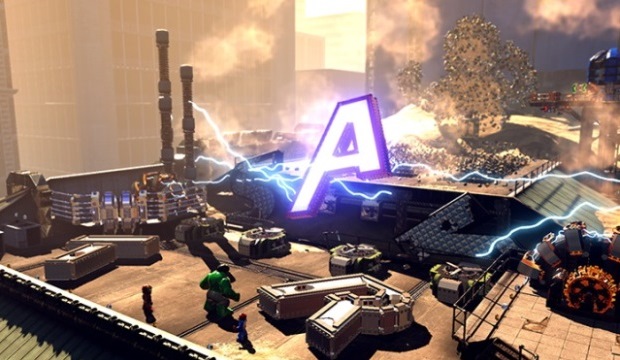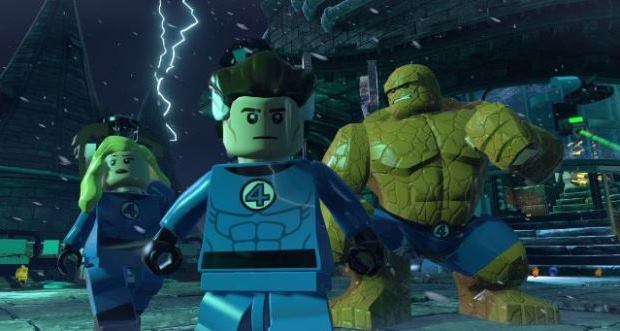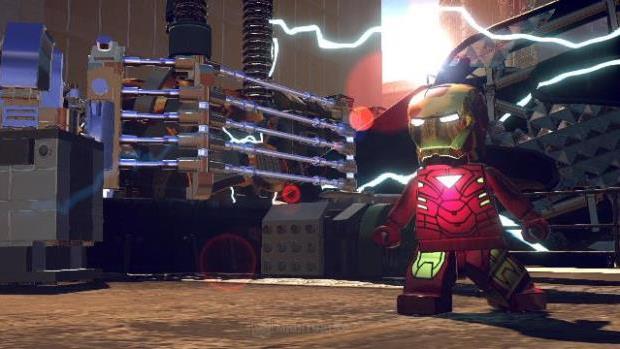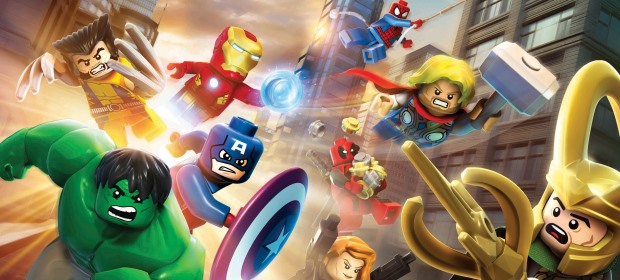Despite this being the umpteenth LEGO video game developed by TT Games, it boasts the most ridiculously huge roster of characters to date, the sprawling Marvel universe coughing up over 150 iconic villains and vigilantes for you to build and smash apart. Such is the wealth of known entities that there aren’t many that seem particularly obscure; indeed, the last decade of cinema ensures that even younger gamers coming into LEGO Marvel Super Heroes will be acquainted with a large percentage of the line-up. It’s a sense of familiarity that pervades the entire experience, and one that proves to be both a blessing and a curse.
For a start, if you’ve ever played one of TT Games’ LEGO titles, you’ll know exactly what to do and how to proceed. Levels are spread around a central hub, and you’ll enter each with a selection of three characters of varying abilities. What follows is a sequence of switch-hitting and rudimentary combat, interspersed with “puzzles” that will barely trouble an 8-year-old. The rock-bottom difficulty is great for youngsters and those who just want to idle away a few hours, but for serious gamers the allure of the LEGO titles has never been the gameplay. It’s TT’s interpretation of each universe that appeals, and once again they’ve proved that simple charm and likability can carry you along way – even if the distance grows shorter with each instalment.

The hub in question this time around is in two parts. The first is the S.H.I.E.L.D. Heli-Carrier, manned by Nick Fury, Agent Coulson, Maria Hill and a lot of random LEGO folk who do an admirable job of making it look like a bustling hive of activity. Here you can select story missions to replay, view your unlocked characters, create your own LEGO hero from bits and pieces of everyone else, and enter into free-play mode by sky-diving off the edge of the gargantuan troop transport. The second part is New York City itself, where you can run around completing a ton of side-quests and checkpoint races, or hoovering up the vast amount of collectibles that litter the world.
It’s an interesting aside, and although in places it feels very vanilla – almost as if TT had bits left over from LEGO City Undercover and wanted to use them up – there’s plenty of idling activities to get on with. You can jump into vehicles to get around quicker, which seems at odds with the universe in general. Why does Iron Man need to steal (well, borrow – this isn’t GTA, after all) a taxi when he can actually fly? Why would Spider-Man drive when he can swing through the city faster? That said, there is a fair bit to do, and being able to switch between your unlocked characters opens up opportunities to use each hero’s powers to gather pick-ups and reach new areas. The vehicle handling is far too loose and unrefined, though, which means you won’t bother using cars for the majority of the time.

The actual story is a bit throwaway, and is really just an excuse to roll all these little sub-universes together. As such, it does a grand job, and the humour holds it all in one piece despite occasionally grating due to its repetitiveness. Set some time after the events of the Avengers movie, it centres on a race between S.H.I.E.L.D. and the “good guys” (The Avengers, the Fantastic Four, the X-Men, etc) and a host of villains including Dr. Doom, the Brotherhood of Mutants and Loki to find all the pieces of the Silver Surfer’s surfboard. Nicknamed “Cosmic Bricks”, these pieces hold a great deal of value to arch-villain Galactus, and the game is split into a series of chases and encounters based around their acquisition.
Beginning as Iron Man, The Hulk, and Spider-Man, you’ll soon get through an impressive line-up including Wolverine, Jean Gray, Black Widow, Beast, and Storm. The rich Marvel universe yields some great special abilities including wall climbing, swinging, flying, invisibility and, of course, clobbering and smashing. The “BIG LEGO” characters like Hulk, Juggernaut and Abomination control like the others, but they can’t assemble items from scattered bricks or use switches, and are instead just there to destroy stuff and throw things. As always, many characters share powers but usually the combinations are fairly unique. For example, Spider-Man and Wolverine can both climb certain walls and use heightened senses to detect the way forward, but Spider-Man can shoot web and swing around while Wolverine can flip heavy switches and destroy concrete walls. Iron Man’s flight works very well, and Magneto’s ability to manipulate metal objects is reminiscent of magic-use in LEGO Lord of the Rings and Harry Potter.

None of the puzzles are in any way taxing, though, and most people will breeze through the story in a matter of hours. It’s always a question of finding the switch and working out which superhero can manipulate it, then moving on and repeating it until the mid and end-level boss fights. These, too, are incredibly simple, and the lack of any kind of fail state means you can just exercise trial and error until you find a solution or fluke your way through. They each present a different challenge, for example: Venom requires you to use loud noises to subdue him, but Sabretooth needing a good chunk of scenery in the face. The McGuffin nature of every item you’re tasked to assemble begins to irritate almost immediately, however, when you’re smashing up objects and assembling huge water cannons out of nowhere to defeat the Sandman during a showdown in Grand Central Station. The fact that you can simply build anything you need with zero thought or effort is almost insulting (you can even construct a giant boombox to hurt Venom, which just seems ludicrous, even in the context of the universe).
It’s a shame, because such simple mechanics actually detract from the fun. It all feels very by-the-numbers and, in a game that’s already following such a well-worn template, that equals large periods where you can deactivate your brain and go through the motions with your eyes half-closed. It’s great to play as so many of your favourite characters, and teaming up heroes from different sub-universes like The Thing, Cyclops, Thor, and Spider-Man is always crowd-pleasing; it’s just all very “been there, done that”.

Graphically, Marvel Super Heroes is very strong. The character models are unmistakable, the environments as colourful and blocky and busy as we’ve come to expect. That said, the interpretation of New York City is too bland at times, and you may often find yourself wishing for the more confined spaces of the missions. The music borrows theme tunes from several franchises, particularly the stirring Avengers Assemble score, and does an admirable job of conveying the desired atmosphere, but the script is so-so. Occasionally it’s very funny, and the voice actors do well to impersonate the many character ticks and idiosyncrasies made recognisable by the recent spate of Marvel movies, but the script is composed almost exclusively of one-liners and the set-ups for one-liners. It has moments of gold, but the constant hamminess can become tedious.
VERDICT: There’s no denying that TT Games have once again done a well-loved universe justice with Marvel Super Heroes, but the lack of any real challenge and the instant-win feel of every encounter and low-rent puzzle means that there’s little actual play value for gamers over a certain age. The characters are represented with aplomb, and the simple but enjoyable story keeps things ticking along nicely, but it’s hard to escape the feeling that this franchise needs a serious overhaul going into the next generation. There will always be a place for LEGO games as long as there are iconic franchises to re-dress, but it’s time TT took the concept back to the drawing board and shook up the core mechanics.
LEGO Marvel Super Heroes is proof that both franchises have their place and appeal in the video games industry, but it’s also horribly exposing of the repetitive, tired mechanics employed to actually create a workable gameplay experience. There’s so much easy, cutesy charm and friendly appeal about LEGO Marvel Super Heroes that it’s easy to find yourself bewitched by it, and lose sight of the fact that there’s not really much substance beneath the flashy suit.

GOOD. A game that scores 7/10 is worthy of note, but unworthy of fanfare. It does many things well, but only a few of them incredibly well and, despite a handful of good qualities, fresh ideas and solid mechanics, it fails to overwhelm.
Review copy provided by publisher.





